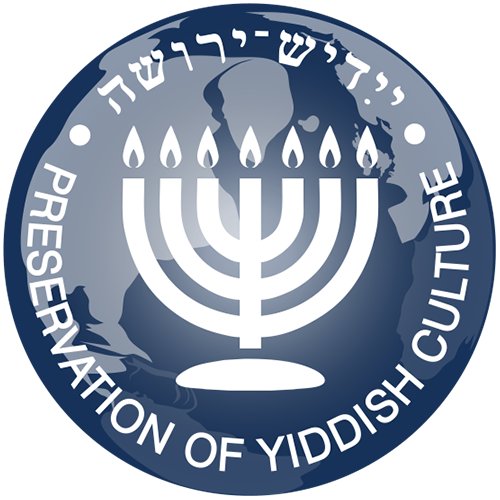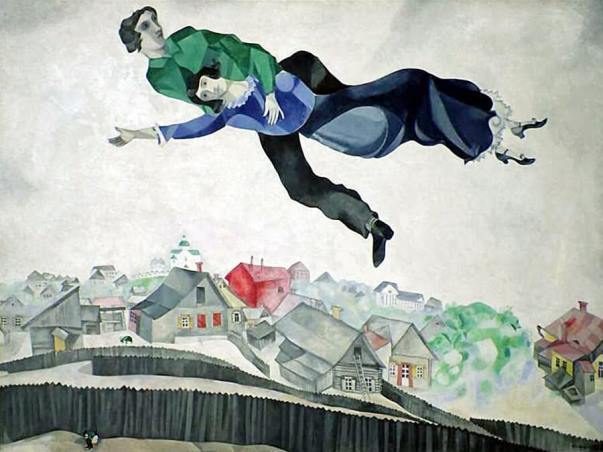Yiddish and World Culture
If we would attempt to talk about the general influence of the Jewish culture in the world, without any reference to a specific language, then we would have to begin with the Tanakh, the Jewish Bible. It has become one of the most fundamental texts of the Western culture in its most diverse manifestations. Literature, art, theater, cinema, philosophy, and not only limited to Western civilization, are ubiquitously permeated by stories, concepts and themes stemming from the Tanakh. As it is known, the Jews are often called “the people of the book”, the “book” being primarily the Tanakh. However, the language of the Tanakh is Hebrew, not Yiddish. In comparison to the culture of the Tanakh, Yiddish culture is relatively young.
Marc Chagall. Over the Town. 1918
The question about its influence on world culture is not trivial at all. To what degree, in what ways and peculiar manifestations did Yiddish influence the great world cultures? The answer to this question requires some serious preliminary examination.
Not attempting to give right away a detailed answer, we will now only make a few basic observations on how Yiddish culture manifests itself outside of its traditional sphere:
1. Unlike the Jewish culture in general, whose literary tradition emerged in the ancient Middle East and expressed itself in Semitic languages foreign to Europe, i.e. Hebrew and Aramaic, Yiddish culture, while being nationally Jewish, is undoubtedly a European one. Like the Yiddish language itself, it emerged and developed over centuries in Europe. Despite its use of the Hebrew alphabet, which is incomprehensible to the vast majority of Europeans, Yiddish culture is an integral part of the European cultural landscape. Many manifestations of Yiddish culture are essentially Jewish-flavored varieties of European cultures. One may say that they are “Jewish responses to the Christian challenge”. This is a natural outcome of the fact that until recent times, Jews were the only non-Christian religious minority in Christian Europe. Not surprisingly, this minority was in constant cultural dialogue with the surrounding majority.
2. Emerged in the 19th century, modern forms of Yiddish culture are relatively young. Like many other young European cultures, it needed to assert itself, to receive at least some recognition in the broader context of the Western culture, outside of its Jewish environment, both in Europe and America. To a certain extent, it had already succeeded to acclaim its respected place in the West during the first half of the 20th century.
3. The first step towards obtaining such recognition was the availability of translations from Yiddish into other languages. Such translations began to appear at the end of the 19th century (primarily into Russian, Polish and German). In the following years, the number of translations increased, as did the number of languages in which they were published.
4. Sholem Asch (1880‒1957) was, arguably, the first writer who wrote in Yiddish and became popular in the non-Jewish world. Already during his lifetime, his works were translated into a number of languages, including English.
5. In the first half of the 20th century, Yiddish theater received wide recognition. As an illustrative example of its global acknowledgment we may quote the words of the outstanding British stage director Edward Henry Gordon Craig (1872–1966). After visiting the Moscow State Jewish Theater in 1935, he said: “Now it is clear to me why there is no real Shakespeare in English theater. Because they do not have there such actor as Mikhoels.” William Shakespeare’s classic play King Lear was brilliantly translated into Yiddish by the Jewish poet Shmuel (Samuel) Halkin (1897–1960). Craig greatly admired its staging at the Moscow State Jewish Theatre with Shloyme (Solomon) Mikhoels (1890‒1948) playing the main protagonist.
6. After the Holocaust, which destroyed the historical Yiddishland, the borderless virtual country of Yiddish, the interest in Yiddish culture and, in particular, in its literature, increased both in Western and Eastern European countries, where this virtual country had been existing for centuries, primarily in Poland, Lithuania, Ukraine, Belarus. This interest was not only limited to the phenomenal popularity of Isaac Bashevis Singer (1902‒1978) who received the Nobel Prize in literature for his Yiddish works. The emergence of numerous translations of Israel Joshua Singer (1893‒1944), Moyshe Kulbak (1896‒1937), Dvoyra Vogel (1902‒1942), Avrom Sutzkever (1913‒2010) and many other Yiddish authors also indicates the increase of global interest in Yiddish literature.
7. It became very popular to translate the works of Sholem Aleichem (1859–1916) who is generally regarded the greatest classic of Yiddish literature not only into European languages, but also into East Asian ones. The American musical Fiddler on the Roof, based on Sholem Aleichem’s stories about Tevye the Dairyman, is considered nowadays a world masterpiece of its genre.
8. Without any doubt, there is a strong global influence of Yiddish culture in the world of the avant-garde art. Names such as Max Weber (1881-1981), Robert Falk (1886-1958), Marc Chagall (1887-1985), Issachar Ber Rybak (1897-1935), Boris Aronson (1900‒1980) and others are well-known to art experts and connoisseurs all over the world.
9. There is another very special, and yet practically unexplored, but interesting phenomenon: the indirect influence of Yiddish culture on other cultures through Jewish authors who wrote in non-Jewish languages, but spoke Yiddish and were familiar with its literature. As for Russian literature, we can mention the popular novel The Twelve Chairs by Ilya Ilf and Yevgeny Petrov. One clear example of such indirect influence are the letters of the Orthodox Christian priest Father Fyodor written to his wife, featured in this novel, which undoubtedly owe their origin to Sholem Aleichem’s short novel Menakhem-Mendl, whose eponymous protagonist corresponded with his spouse in a remarkably similar style.

